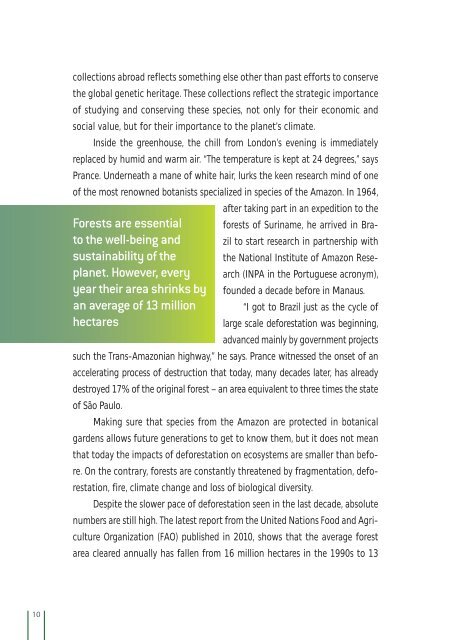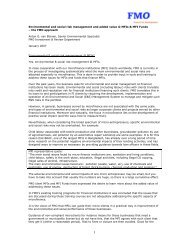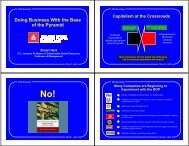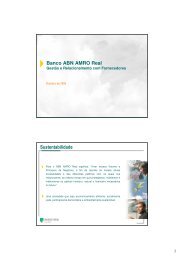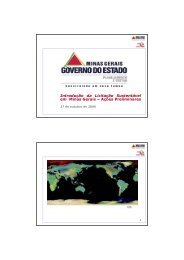From the forest to the consumer - GVces - Fundação Getulio Vargas
From the forest to the consumer - GVces - Fundação Getulio Vargas
From the forest to the consumer - GVces - Fundação Getulio Vargas
You also want an ePaper? Increase the reach of your titles
YUMPU automatically turns print PDFs into web optimized ePapers that Google loves.
10<br />
collections abroad reflects something else o<strong>the</strong>r than past efforts <strong>to</strong> conserve<br />
<strong>the</strong> global genetic heritage. These collections reflect <strong>the</strong> strategic importance<br />
of studying and conserving <strong>the</strong>se species, not only for <strong>the</strong>ir economic and<br />
social value, but for <strong>the</strong>ir importance <strong>to</strong> <strong>the</strong> planet’s climate.<br />
Inside <strong>the</strong> greenhouse, <strong>the</strong> chill from London’s evening is immediately<br />
replaced by humid and warm air. “The temperature is kept at 24 degrees,” says<br />
Prance. Underneath a mane of white hair, lurks <strong>the</strong> keen research mind of one<br />
of <strong>the</strong> most renowned botanists specialized in species of <strong>the</strong> Amazon. In 1964,<br />
after taking part in an expedition <strong>to</strong> <strong>the</strong><br />
Forests are essential <strong>forest</strong>s of Suriname, he arrived in Bra-<br />
<strong>to</strong> <strong>the</strong> well-being and zil <strong>to</strong> start research in partnership with<br />
sustainability of <strong>the</strong> <strong>the</strong> National Institute of Amazon Rese-<br />
planet. However, every arch (INPA in <strong>the</strong> Portuguese acronym),<br />
year <strong>the</strong>ir area shrinks by founded a decade before in Manaus.<br />
an average of 13 million “I got <strong>to</strong> Brazil just as <strong>the</strong> cycle of<br />
hectares<br />
large scale de<strong>forest</strong>ation was beginning,<br />
advanced mainly by government projects<br />
such <strong>the</strong> Trans-Amazonian highway,” he says. Prance witnessed <strong>the</strong> onset of an<br />
accelerating process of destruction that <strong>to</strong>day, many decades later, has already<br />
destroyed 17% of <strong>the</strong> original <strong>forest</strong> – an area equivalent <strong>to</strong> three times <strong>the</strong> state<br />
of São Paulo.<br />
Making sure that species from <strong>the</strong> Amazon are protected in botanical<br />
gardens allows future generations <strong>to</strong> get <strong>to</strong> know <strong>the</strong>m, but it does not mean<br />
that <strong>to</strong>day <strong>the</strong> impacts of de<strong>forest</strong>ation on ecosystems are smaller than before.<br />
On <strong>the</strong> contrary, <strong>forest</strong>s are constantly threatened by fragmentation, de<strong>forest</strong>ation,<br />
fire, climate change and loss of biological diversity.<br />
Despite <strong>the</strong> slower pace of de<strong>forest</strong>ation seen in <strong>the</strong> last decade, absolute<br />
numbers are still high. The latest report from <strong>the</strong> United Nations Food and Agriculture<br />
Organization (FAO) published in 2010, shows that <strong>the</strong> average <strong>forest</strong><br />
area cleared annually has fallen from 16 million hectares in <strong>the</strong> 1990s <strong>to</strong> 13


